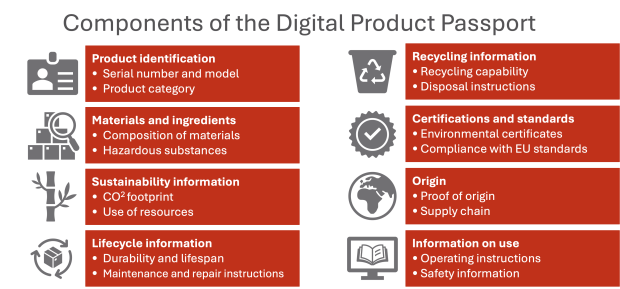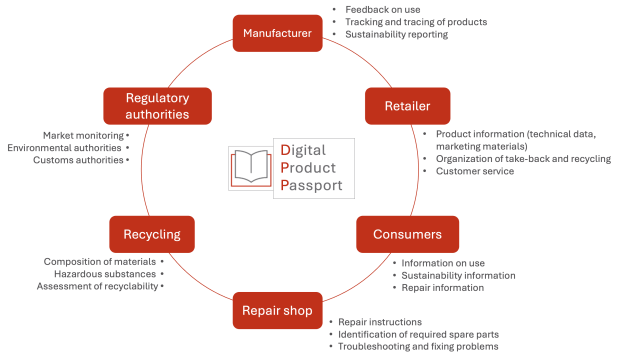Digital Product Passport – What manufacturers need to know and prepare now
In July 2024, the Ecodesign Regulation replaced the Ecodesign Directive in the EU to improve the energy efficiency and environmental performance of products through stricter requirements. The regulation covers a wide range of products such as household appliances, electronics, and lighting, and is part of the EU's strategy to reduce CO2 emissions and promote a circular economy.
One part of this regulation is the Digital Product Passport (DPP), which is designed to ensure transparent traceability throughout a product's lifecycle. The Digital Product Passport is still in draft form. It will be mandatory for manufacturers of certain products.
The new regulation significantly expands the range of affected products, including textiles and construction products. To comply with the regulation, manufacturers must carefully plan and implement the Digital Product Passport.
This article is written for product manufacturers facing the challenge of implementing a Digital Product Passport. We provide an overview of the following aspects:
- What is the Digital Product Passport?
- What does the Digital Product Passport do?
- Timeline for the Digital Product Passport
- When is the Digital Product Passport applicable and when will the Digital Product Passport be mandatory?
- What do you need to do as a manufacturer to include a Digital Product Passport?
What is the Digital Product Passport?
The Digital Product Passport (DPP) is a dataset that contains information about a specific product as required by the Ecodesign Regulation. This dataset must be made available electronically so that it can be accessed online 24/7.
The Digital Product Passport includes comprehensive information on, among other things:
- Materials
- Product components
- Energy efficiency
- Product origin
- Repair options
- Disposal options
The key features of the Digital Product Passport are:
- Information and data: The information in the Digital Product Passport enables consumers to make informed decisions, and manufacturers to make their supply chains more transparent.
- Accessibility: The Digital Product Passport is available digitally and can be easily made available through QR codes or other digital interfaces. This ensures easy and quick access to relevant information.
- Lifecycle: The Digital Product Passport covers the entire lifecycle of a product, from manufacturing and use to disposal or recycling. This makes the sustainability of a product traceable throughout its lifecycle.
- Standardization: The Digital Product Passport follows standardized formats and specifications to ensure comparability between different products and manufacturers. Standardization facilitates integration with existing systems and processes.
- Obligations: Manufacturers and importers are required to provide the necessary data for the Digital Product Passport and to update it regularly. This includes compliance with privacy and security requirements.
What is the purpose of the Digital Product Passport?
The Digital Product Passport (DPP) aims to support consumers in their decision-making and to encourage them to make more sustainable choices.
In addition, manufacturers can use the Digital Product Passport to meet information requirements, e.g. on the availability of spare parts and how to order them, or to provide a repair manual via the Digital Product Passport.
In summary, the benefits for the various stakeholders are as follows:
- Consumers receive detailed information on product selection, sustainable use and disposal.
- Manufacturers can make their sustainability efforts more transparent and gain competitive advantage.
- Regulators get a better database for monitoring and enforcing environmental standards.
There are other stakeholders who can use information from the Digital Product Passport in addition to those mentioned above. The following diagram illustrates the interests and roles of different stakeholders.
The DPP is intended to be an important step towards promoting more sustainable consumption and production patterns in the EU and supporting the objectives of the European Green Deal.
Planned timeframe for implementing the Digital Product Passport (DPP)
The new Ecodesign Regulation (EU) 2024/1781 came into effect on July 18, 2024. However, it will be several years before the regulation becomes mandatory: EU member states must only begin incorporating the regulations into their national legal systems in 2027.
The timeframe for full implementation includes several phases:
1) Preparation and consultation (2022-2024):
- The Ecodesign Regulation, including the Digital Product Passport, is presented in 2022.
- The EU Commission consults stakeholders to define the requirements and framework for the Digital Product Passport.
- The Ecodesign Regulation comes into effect on July 18, 2024.
2) Pilot phase 2 and first implementation (2025-2026)
- A pilot phase selects specific product groups to test the operation of the system.
- The first implementation of the Digital Product Passport starts for certain product categories.
3) Gradual expansion (2026 onwards)
- The Digital Product Passport gradually extends to a wider range of products.
4) Implementation (2027-2030)
- From 2027 to 2030, EU Member States integrates the Digital Product Passport into their national legal systems. The DPP should then cover a wide range of products.
- The Digital Product Passportshould be regularly adapted to technological developments and market needs.
Consequences and challenges of the Digital Product Passport for companies
Companies need a concept for implementing the requirements of the Digital Product Passport (DPP) from a technical and organizational point of view.
For example, the following aspects should be considered:
Data management
- Data collection: Manufacturers need to implement systems to collect and manage the required product information. This may include product information management (PIM) or product lifecycle management (PLM) systems.
- Data quality: Ensuring that data is accurate, complete, and up to date by performing regular checks.
Integration with business processes
- Business processes: Adapting internal processes to integrate data collection and maintenance for the Digital Product Passport
- Staff training on the use and maintenance of the Digital Product Passport
Example
According to the Ecodesign Directive, certain products must be repairable. Therefore, the design of a product must be adapted so that it can be repaired. Furthermore, the information about the repairability must be documented and, if necessary, repair instructions must be written, or staff must be trained on the repair process internally/externally.
Request a consultation to learn more about digital product information!
How can a company implement the Digital Product Passport?
The following concept describes the steps and issues a company should consider when implementing a Digital Product Passport:
1) Needs analysis and objectives
- Requirements analysis: Analyze the needs and benefits of a Digital Product Passport for your organization. Identify the specific requirements you want to achieve by implementing a DPP (e.g. traceability, sustainability, regulatory requirements).
- Objectives: Define clear objectives and KPIs for the implementation of the Digital Product Passport.
2) Stakeholders
- Stakeholder identification : Identify all relevant stakeholders, both internally and externally:
- External: e.g. suppliers, customers, recycling companies, regulators
- Internal: e.g. master data management, IT department, production management, product management, technical documentation, service
Encourage collaboration and communication between stakeholders to understand and incorporate their expectations and needs.
3) Technological infrastructure
- System selection: Select appropriate technologies and platforms for the Digital Product Passport. Consider factors such as interoperability, scalability, and security.
- Data integration: Ensure that existing systems and data sources can be integrated. Develop interfaces and APIs to ensure seamless data transfer. Potential data sources that could be integrated include product databases, ERP, or PLM systems.
4) Data management
- Data standards: Establish standards for collecting and storing data. Ensure that data is consistent, complete, and up to date.
For example, the Asset Administration Shell (AAS) can be a data foundation for the Digital Product Passport. The AAS is managed by the Industrial Digital Twin Association (IDTA) and is already widely used in the industry. In an AAS, information for the DPP can be structured and presented in a standardized way. The IDTA already provides examples of sub-models that can be used in the DPP, e.g. for the digital nameplate and the Product Carbon Footprint (PCF). - Data quality: Implement mechanisms to verify and ensure data quality.
5) Process design and implementation
- Process analysis: Analyze existing processes and identify necessary changes or improvements.
- Process integration: Integrate the Digital Product Passport into existing business processes and workflows.
6) Training and change management
- Training: Train employees and stakeholders on how to use the Digital Product Passport and the new processes.
- Change management: Implement a change management program to encourage acceptance and commitment from stakeholders.
7) Pilot phase and feedback
- Pilot phase: Conduct a pilot phase to test the Digital Product Passport on a limited scale and gain first experiences.
- Feedback: Gather feedback from users and stakeholders to identify areas for improvement.
8) Scaling and continuous improvement
- Scaling: After a successful pilot phase, gradually scale the Digital Product Passport to the entire organization.
- Continuous improvement: Establish processes to continuously monitor and improve the Digital Product Passport.
9) Regulatory and legal requirements
- Compliance: Ensure that the Digital Product Passport meets all relevant regulatory and legal requirements.
10) Sustainability and development
- Sustainability: Implement measures to ensure the long-term sustainability of the Digital Product Passport.
- Innovation: Stay on top of technological developments and best practices and incorporate these in the Digital Product Passport.
Request a consultation to learn more about digital product information!


